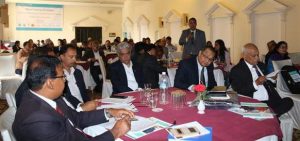
by Keshav Prasad Sah and Varijaksha Panicker Padmakumar ◊
Two of the Feed the Future Innovation Lab for Livestock System’s projects led by Heifer International Nepal held a results-sharing workshop on March 28 in Kathmandu and organized committee meetings that will extend support for both projects, which are nearing completion. The projects focused on mastitis disease control and development of a ration balancing tool for livestock.
For the mastitis disease control project, studies in Nepal have shown that the prevalence of sub-clinical mastitis or udder inflammation ranges widely from 13 to 60 percent. Due to reduced milk production, cow illness or death, drug costs and discarded milk, mastitis causes substantial financial losses to small-scale farmers, the dairy industry and it may threaten the health of consumers of milk from such cows. The project studied the efficacy of mastitis prevention and control technologies, such as the California Mastitis Test, Milk Conductivity Tests, Post-Milking Teat Dipping, and Dry Cow Therapy, as well as training farmers on Good Husbandry Practices. During the past year, 400 dairy farmers involved in the study observed decreases in the incidence of mastitis in both cows and buffaloes after adopting the prevention strategies.
Regarding livestock feeding, many farmers in Nepal use traditional systems based on the availability of feed resources and not on meeting animal requirements. Even among farmers who have knowledge about quality feeds, only a few practice balancing the energy, protein, calcium and phosphorus levels in the diet to match the requirements of the cow. The project’s user-friendly smartphone app, a Feed Support Tool, adapted to Nepalese circumstances, calculates nutrient-balanced diets for dairy animals based on available local feed resources. The enduring impacts of the app may include reduced production costs and increased farmer income.
Scaling Up Across Nepal
Building on the accomplishments of these two projects, the results-sharing workshop drew active participation from the Government of Nepal and included the Nepal Agriculture Research Council, Nepal Dairy Development Board, farmers, project participants, dairy associations and related stakeholders. Workshop chair Dr. Bimal Kumar Nirmal, the Director General of the Department of Livestock Services, formed two committees to develop strategies and action plans to scale-up the findings of the two projects. Funding for the committees was promised by the Joint secretary from the Ministry of Agriculture, Land Management and Cooperatives.
Action plans for the two committees include:
- Enabling government dairy farms to become free from mastitis disease, by establishing a system of regular use of mastitis testing and control technologies
- Creating a new “Mastitis control strategy” and “National code of practice for mastitis control”
- Establishing a lab in Nepal that uses Near Infrared Reflectance Spectrophotoscopy (NIRS) to foster rapid, low cost analysis of feed samples
- Piloting training for the Feeding Support Tool in ten or more major dairy zones in seven provinces.
The two committees are working through their respective coordinators to follow-up on the action plan as agreed during the workshop. As one of the most important sub-sectors in Nepal’s livestock sector, dairy contributes to almost two-thirds of the livestock share of Gross Domestic Product (GDP). Dairy has great potential for raising incomes as well as for contributing to the nutrition of smallholder dairy farming families.
Watch this video about the two projects, created by Heifer International Nepal:
 0
0
